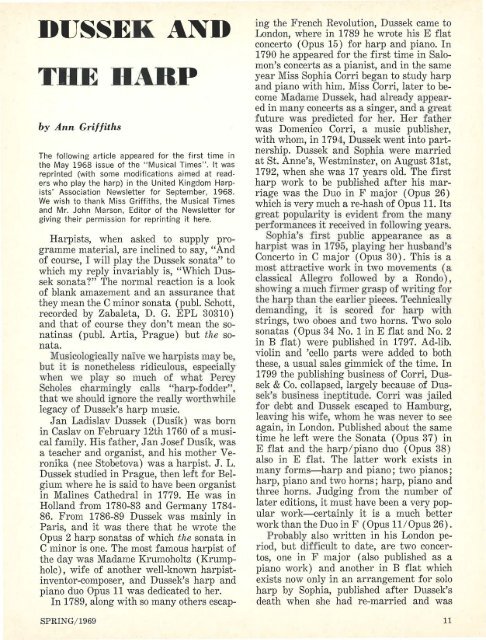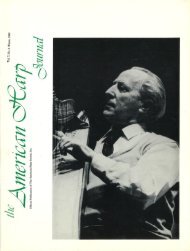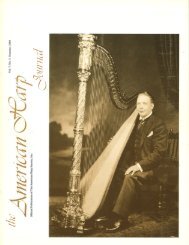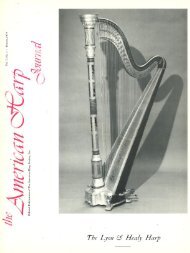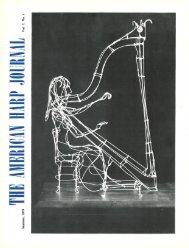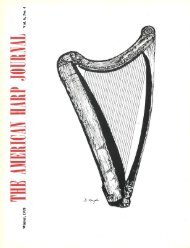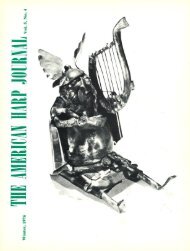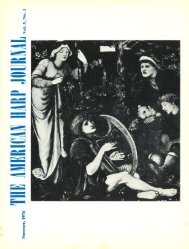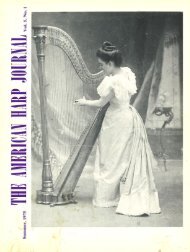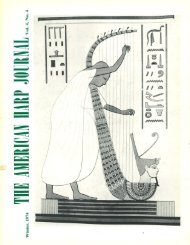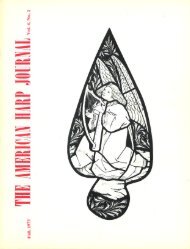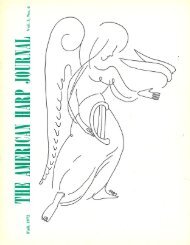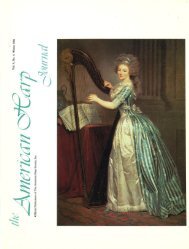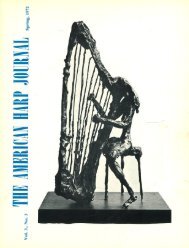AHJ, Vol. 2 No. 1, Spring 1969
AHJ, Vol. 2 No. 1, Spring 1969
AHJ, Vol. 2 No. 1, Spring 1969
You also want an ePaper? Increase the reach of your titles
YUMPU automatically turns print PDFs into web optimized ePapers that Google loves.
DUSSEK AND<br />
THE HARP<br />
by Ann Griffiths<br />
The following article appeared for the first time in<br />
the May 1968 issue of the "Musical Times". It was<br />
reprinted (with some modifications aimed at readers<br />
who play the harp) in the United Kingdom Harpists'<br />
Association Newsletter for September, 1968.<br />
We wish to thank Miss Griffiths, the Musical Times<br />
and Mr. John Marson, Editor of the Newsletter for<br />
giving their permission for reprinting it here.<br />
Harpists, when asked to supply programme<br />
material, are inclined to say, "And<br />
of course, I will play the Dussek sonata" to<br />
which my reply invariably is, "Which Dussek<br />
sonata?" The normal reaction is a look<br />
of blank amazement and an assurance that<br />
they mean the C minor sonata (publ. Schott,<br />
recorded by Zabaleta, D. G. EPL 30310)<br />
and that of course they don't mean the sonatinas<br />
(publ. Artia, Prague) but the sonata.<br />
Musicologically naive we harpists may be,<br />
but it i s nonetheless ridiculous, especially<br />
when we play so much of what Percy<br />
Scholes charmingly calls harp-fodder' ,<br />
that we should ignore the really worthwhile<br />
legacy of Dussek's harp music.<br />
Jan Ladisla v Dussek (Dusik) was born<br />
in Caslav on February 12th 1760 of a musical<br />
family. His father, Jan Josef Dusik, was<br />
a teacher and organist, and his mother Veronika<br />
(nee Stobetova) was a harpist. J. L.<br />
Dussek studied in Prague, then left for Belgium<br />
where he is said to have been organist<br />
in Malines Cathedral in 1779. He was in<br />
Holland from 1780-83 and Germany 1784-<br />
86. From 1786-89 Dussek was mainly in<br />
Paris, and it was there that he wrote the<br />
Opus 2 harp sonatas of which the sonata in<br />
C minor is one. The most famous harpist of<br />
the day was Madame Krumoholtz ( Krumpholc),<br />
wife of another well-known harpistinventor-composer,<br />
and Dussek's harp and<br />
piano duo Opus 11 was dedicated to her.<br />
In 1789, along with so many others escap-<br />
SPRING/ <strong>1969</strong><br />
ing the French Revolution, Dussek came to<br />
London, where in 1789 he wrote his E flat<br />
concerto ( Opus 15) for harp and piano. In<br />
1790 he appeared for the first time in Salomon's<br />
concerts as a pianist, and in the same<br />
year Miss Sophia Corri began to study harp<br />
and piano with him. Miss Corri, later to become<br />
Madame Dussek had already appeared<br />
in many concerts as a singer, and a great<br />
future was predicted for her. Her father<br />
was Domenico Corri, a music publisher<br />
with whom, in 1794, Dussek went into part~<br />
nership. Dussek and Sophia were married<br />
at St. Anne's, Westminster, on August 31st,<br />
1792, when she was 17 years old. The first<br />
harp work to be published after his marriage<br />
was the Duo in F major ( Opus 26)<br />
which is very much a re-hash of Opus 11. Its<br />
great popularity is evident from the many<br />
performances it received in following years.<br />
Sophia's first public appearance as a<br />
harpist was in 1795, playing her husband's<br />
Concerto in C major (Opus 30). This is a<br />
most attractive work in two movements (a<br />
classical Allegro followed by a Rondo)<br />
showing a much firmer grasi:> of writing for<br />
the harp than the earlier pieces. Technically<br />
demanding, it is scored for harp with<br />
strings, two oboes and two horns. Two solo<br />
sonatas (Opus 34 <strong>No</strong>. 1 in E flat and <strong>No</strong>. 2<br />
in B flat) were published in 1797. Ad-lib.<br />
violin and 'cello parts were added to both<br />
these, a usual sales gimmick of the time. In<br />
1799 the publishing business of Corri, Dussek<br />
& Co. collapsed, largely because of Dussek'<br />
business ineptitude. Corri was jailed<br />
for ~lebt ~nd _Dussek escaped to Hamburg,<br />
leavmg bis wife, whom he was never to see<br />
again, in London. Published about the same<br />
time he left were the Sonata (Opus 37) in<br />
E flat and the harp/ piano duo (Opus 38)<br />
also in E flat. The latter work exists in<br />
many f ?rms-harp and piano; two pianos ;<br />
harp, piano and two horns; harp, piano and<br />
three horns. Judging from the number of<br />
later editions, it must have been a very popular<br />
work-certainly it is a much better<br />
work than the Duo in F (Opus 11 / Opus 26).<br />
Probably also written in his London period,<br />
but difficult to date, are two concertos,<br />
one in F major ( also published as a<br />
piano work) and another in B flat which<br />
exists now only in an arrangement for solo<br />
harp by Sophia, published after Dussek's<br />
death when she had re-married and was<br />
11


